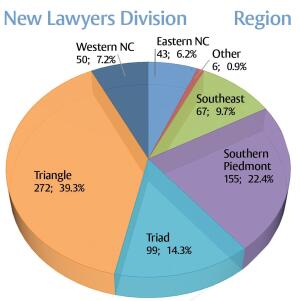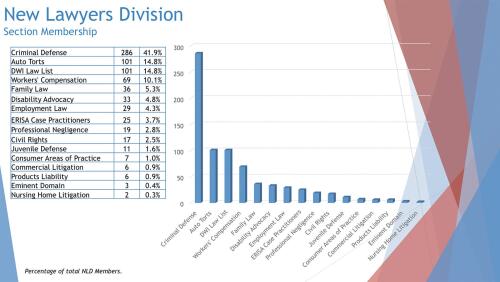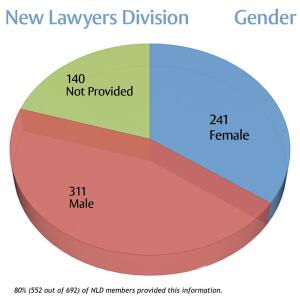The Disappearing Young Attorney
 A recent North Carolina Advocates for Justice publication, Trial Briefs, printed three essays that share the personal experiences, perspectives and obstacles faced by three attorneys beginning their careers in North Carolina. We hope these can be instructive as we continue to discuss changes to the legal profession in the coming months and years.
A recent North Carolina Advocates for Justice publication, Trial Briefs, printed three essays that share the personal experiences, perspectives and obstacles faced by three attorneys beginning their careers in North Carolina. We hope these can be instructive as we continue to discuss changes to the legal profession in the coming months and years.
As an attorney in my fifth year of practice, I am a part of an ever-shrinking minority. According to the most recent data made available by the American Bar Association, only four percent of licensed lawyers are thirty years of age or younger. In the early 1980s, this same age demographic made up more than fifteen percent of the bar. Similarly, during the past four decades, the percentage of lawyers who were thirty-five years of age or younger has been cut in half—from thirty-six percent to thirteen percent.
Despite the myth that law schools have recently flooded the profession with hundreds of thousands of excess Millennial and younger Generation X attorneys, this didn’t happen. Al- though law schools have exponentially increased their class sizes and graduation numbers, over the past several decades, a vast number of newly minted Juris Doctors have either quickly left the practice of law, for whatever reason, or never obtained legal employment.
Since 1980, the median age of the American lawyer has in- creased from thirty-nine to approximately fifty years of age. The reality is that Baby-Boomer attorneys are not retiring. Today, around thirty-five percent of the nation’s lawyers are fifty-five years of age or older, compared to what was nearly half that during the Carter administration.

Some older attorneys aren’t aware of the shifting demo- graphics, and these numbers come as a surprise. It doesn’t impact them. Most young attorneys sense that something is amiss, as each year passes, we remain the youngest people in the room. Our names continue to appear last on the law firm letterhead.
A few older attorneys, who are aware of the increasing age of our profession, believe Millennials and younger members of Generation X are not well suited for the practice of law. These older attorneys assign blame to young attorneys for their dwindling numbers. We, young attorneys, know the stereotypes: We want to be trial lawyers who work fifty hours per week. We don’t work hard enough to build a sustainable book of business. We are idealists instead of realists.
The perceived shortcomings of today’s young attorney are the product of labor forces beyond his control. In compar- ing the drastic decrease in the percentage of attorneys under thirty-five years of age with the corresponding doubling in the percentage of attorneys over fifty-five years of age, it is apparent that Baby-Boomers are squeezing Millennials and younger members of Generation X out of the legal profession. The Baby-Boomers’ failure to make way for the new has not only hampered the ability of today’s young attorney to find a job but also business. What client will give a Millennial attorney work when there are ample men with fully-gray hair to hire?
Millennial and younger Generation X lawyers understand that most of our older counterparts like practicing law. We know that they are at the pinnacle of their profession and have years left. We know that they worked hard and earned their success. We respect them and have no right to tell them to make room for us. No matter how many more years may pass, as long as they serve their clients well, they should practice law. We also understand that some older attorneys have no choice but to continue in their practice. Some had their retirement wiped out during the Great Recession, and others are paying their children’s student loans. We know that the economy has played at least some factor in not only keeping our older counterparts around longer, but in also preventing many new Juris Doctors from joining the bar. From 2008 to 2012, the legal market was in crisis, and Millennials distinctly remember seeing job postings demanding candidates from top schools, with top grades, law review, and moot court, starting at $40,000 per year. This was not the fault of our Baby- Boomer counterparts.
However, even if it is not spoken, many young attorneys (both Millennials and younger members of Generation X) harbor at least a little animosity towards their elders, which I suspect may be somewhat more than generations past. Recently, I heard one of my peers say that the only way he would ever have his own clients would be if a particular Baby- Boomer retired or taught him how, and neither was happening anytime soon. (Not that I necessarily believe building business is something that can be taught.)
It seems that Millennial and younger Generation X attorneys on NCAJ’s side of the bar are getting ample hands-on litigation experience. I, and many of my cohorts, were put in front of juries within our first few months of practice. We of course need this traditional trial-by-fire mentoring. In terms of the practice of law, I believe that most of us feel well versed and trained. Nevertheless, in terms of the business of law, it seems that we, on NCAJ’s side of the bar, are universally struggling to take the reins, and we feel more stymied by our elders than generations of young lawyers past—not that our more experienced colleagues should give away the farm.
We can all agree that no one can work forever, and at some point in the not so distant future, our profession’s torch bearers, the Baby-Boomers, will depart. Our profession needs to be prepared for a rapid generational shift. Our big firm opponents seem less ready than us.

In a recent New York Times article, Graying Firms Wrestle with Making Room for Young Lawyers, Elizabeth Olsen dis- cussed how large, big business firms were popularized by the Baby-Boomer generation. She went on to talk about how such firms remain almost exclusively controlled by attorneys over the age of sixty. According to insiders at these firms, very few of them are engaging in succession planning. Their future is on shaky ground, as no one appears poised to take the helm. Almost all Millennial and younger Generation X attorneys.
I know at big corporate firms in North Carolina spend their entire day performing research and writing briefs. Their superiors then go to Court and take credit for their work. They have never tried a case, much less on their own. They have minimal client contact. They have no idea how to find or re- tain clients, and their firms are not teaching them either the practice or business of law. What will become of these firms and lawyers in ten to twenty years?
Although this article has focused on national statistics, it is specifically about what is occurring in our State. In 1991, according to the State of the Profession Survey, sponsored by the North Carolina Chief Justice’s Commission on Professionalism, the average age of the North Carolina lawyer was forty years old. In 2003, this same survey found that the aver- age age of the North Carolina lawyer was forty-six years old, an increase of six years over 1991. These numbers roughly track the American Bar Association’s average age of the American lawyer during this same time period. Since 2003, no further State of the Profession Surveys have been published with similar data. However, assuming that the trend in North Carolina continued to mirror what was happening nationwide, today, the average age of the North Carolina law- yer is around fifty years old.

Unfortunately, readily available demographic data on our State’s lawyers is limited. To the best of my findings, our State Bar did not begin publicly reporting demographic data on North Carolina’s legal populace until 2012. The State Bar’s report only includes information about licensed lawyers who voluntarily completed an online survey and consented to their information being included in reported data. Of the approximately 23,000 licensed attorneys in North Carolina, only 12,100 have participated.
Of the voluntary participants, ten percent were thirty years of age or younger, while approximately forty percent were fifty years of age or older, and a little more than twenty percent were sixty years of age or older. (Note: Due to the manner in which the State Bar reported the data, an aver- age age and comparable State figures to the American Bar Association’s national percentages of lawyers under the age of thirty-five and over the age of fifty-five cannot be deter- mined.) Since the primary method of the State Bar’s survey’s data collection is online, one may assume that there is a greater percentage of participation among younger generations of lawyers than older. Adjusting for this, the percent- ages of young and older attorneys in North Carolina are in line with the nationwide statistics.
For now, in North Carolina, and nationwide, young attorneys must learn to survive and cope with more competition than ever from more experienced attorneys—which is certainly a difficult task. Telling potential clients that we are more energetic and can devote more time to their case can only go so far without older mentors providing support. Nevertheless, Millennials and younger members of Generation X could be quite pleased by their dwindling numbers upon the Baby-Boomers’ departure. Near the height of our careers, much work will become available when there are few experienced lawyers to hire.
This post was originally published in the North Carolina Advocates for Justice's Trial Briefs magazine ( April 2016 issue) and has been reprinted with permission from the NCAJ.



